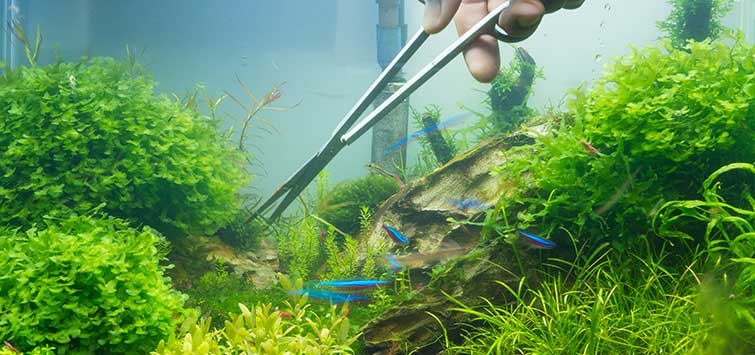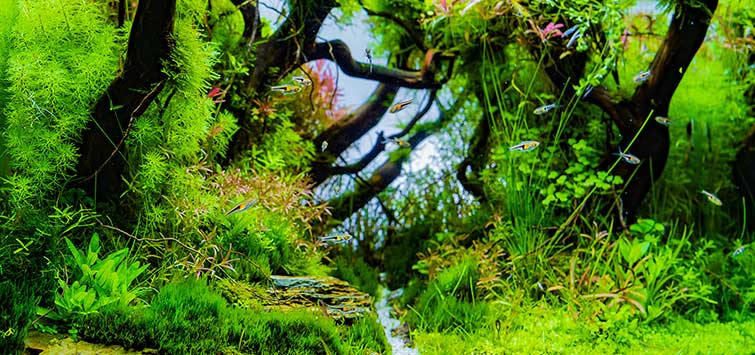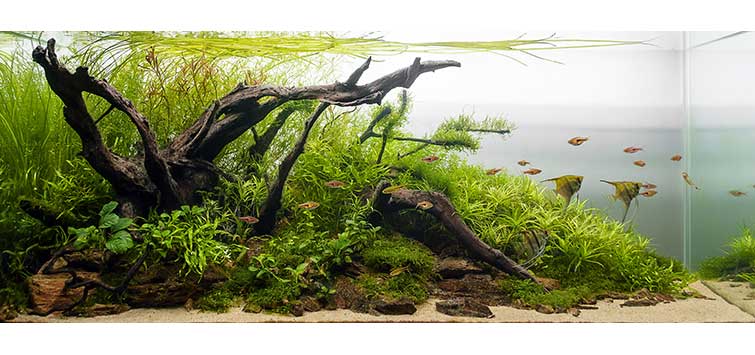Trimming to Refine the Nature Aquarium
Trimming to Refine the Nature Aquarium
Author: Takashi Amano
The planted tank virtuoso shares his method for trimming plants in the Nature Aquarium to both maintain and improve the layout over time.
In previous articles, I mainly discussed my method of creating an aquatic plant layout and growing aquatic plants in the Nature Aquarium style. The Nature Aquarium aesthetic places importance on not only arranging aquatic plants, but also growing the aquatic plants over time and thus producing naturalistic scenery in an aquarium. Aquatic plants must grow in a healthy manner for this to happen.
However, plant growth alone does not create beautiful scenery. Different aquatic plants grow at different speeds, and there is a limit to the volume of an aquarium as well. Left unchecked, faster-growing plants will quickly fill up the empty space of an aquarium, and the layout will be ruined no matter how carefully you have designed its composition and arrange the aquatic plants within. It is for this reason that we must trim the aquatic plants in a Nature Aquarium layout in order to control their volume.
In the Nature Aquarium, trimming is performed repeatedly not only to maintain a layout but also to refine the finished layout. There are generally three trimming methods I use: one is a method used to form stem plants into bushes; another is a method to keep the low growing aquatic plants in the foreground from getting matted; and lastly is a method to trim off the leaves of Cryptocoryne and ferns that have grown too large to maintain a proper aquascape.
BACK- AND- MIDDLE GROUND
Many aquatic plants have remarkable reproductive abilities and develop new stems and leaves successively even when they are cut off. Stem plants in particular develop multiple new shoots and form branches through repeated trimmings. The density of stems and leaves increases through repeated trimmings, and beautiful bushes are formed.
Although the nodes of newly planted stem plants are often long and their leaves may be large, if provided with a good environment in an aquarium, the nodes shorten and leaves become uniformly small through trimming. The same thing is true for Glossostigma, which is often planted in the foreground. The leaves that develop right after planting are somewhat large, but with repeated trimming, the leaves become smaller and they grow denser as well.
Stem plants are shaped by changing the angle of scissors so that the cut surfaces form a gentle sphere. During the first trimming, the stems are cut short. With the subsequent trimmings, stems are cut gradually at higher positions. Doing so encourages the stem plants to develop multiple branches and form dense bushes. Cut-off stems should be removed, and they can be grown in another aquarium.
It is important to use a pair of scissors made for trimming (a straight type) which have long and very sharp blades. Longer blades can cut a wide swath, and they are well suited for shaping stem plants into bushes. Sharp scissors are less damaging to aquatic plants during trimming, and the plants develop new shoots sooner when cut with sharper scissors.
Although shade-loving plants such as Cryptocoryne and ferns grow relatively slowly, their leaves grow progressively larger. Bolbitis grown attached to driftwood in particular tend to overwhelm an aquascape when their leaves grow large and get too close to the front glass. Therefore it is necessary to cut off large leaves to keep them from overwhelming the aquascape.
FOREGROUND PLANTS
Glossostigma plants in the foreground form a thick layer of runners, and their leaves and the lower parts of each plant where light does not penetrate well start to die off. Therefore the top part of Glossostigma should be trimmed off, leaving a single layer of runners before they become very thick. Since Glossostigma needs to be trimmed uniformly and very close to the substrate, trimming is difficult to do with a regular trimming scissors. Trimming scissors with a curved tip should be used for this purpose. Curved-tip trimming scissors can trim Glossostigma uniformly thin without the need for turning the scissors horizontally. As in the case of stem plants, sharp scissors are less damaging to Glossostigma and their leaves will grow back faster.
Hair grass is trimmed in the same manner. Hair grass is also trimmed parallel and close to the substrate, leaving mainly their rosettes. When algae attach all over its leaves, the plant can be trimmed in this manner. New clean leaves will develop soon.
Among short-growing foreground plants, cobra grass and European clover develop their leaves rather slowly, and if trimmed the same way as Glossostigma, they do not develop new leaves very quickly. In the case of these plants, old discolored leaves and those to which algae are attached should be cut off individually. If the roots of foreground plants appear exposed after trimming, the roots should be covered with a powder-type soil. New shoots do not develop well if the roots are exposed. After trimming, newly developed leaves are clean and grow densely.
With adequate and proper trimming of the back-, middle-, and foreground, a Nature Aquarium layout appears more finished and refined.
See the full article on TFH Digitalhttp://www.tfhdigital.com/tfh/200710/#pg88

.png?h=595&iar=0&w=2781&hash=5FD5E69473BCC22199FBFA2FB71B6033)



